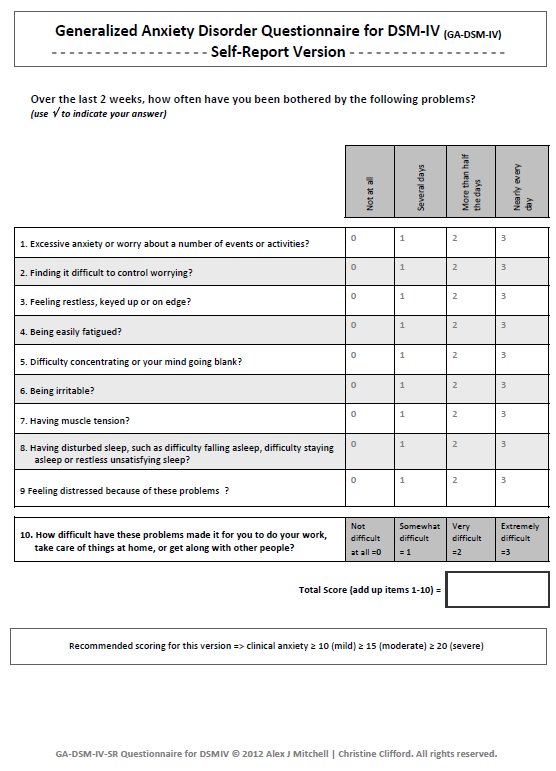Test Anxiety Inventory Spielberger Pdf Viewer


Key Words: Anxiety, Test Anxiety, Psychometric properties, Factor analysis, Test Anxiety Inventory (TAI). In the view point of Reber (1995), anxiety is an emotional state in unpleasant conditions without a. Spielberger (1980) has described three different concepts of test anxiety which are personality trait. 2 The Westside Test Anxiety Scale is an extremely brief screening instrument meant to identify students with anxiety impairments. The scale is comprised of ten items, and. Test Anxiety Inventory. Read each statement carefully. If the statement reflects your experience in taking a test, place a check (√) before that statement. Check as many statements as apply to you. Check a statement if you can see yourself in such a situation or thinking those thoughts. Be totally honest with yourself.
Options for accessing this content: • If you are a society or association member and require assistance with obtaining online access instructions please contact our Journal Customer Services team.. • Login via other institutional login options. • You can purchase online access to this Article for a 24-hour period (price varies by title) • If you already have a Wiley Online Library or Wiley InterScience user account: login above and proceed to purchase the article.
• New Users: Please register, then proceed to purchase the article.
A reliability generalization study for Spielberger’s State-Trait Anxiety Inventory (STAI) was conducted. A total of 816 research articles utilizing the STAI between 1990 and 2000 were reviewed and classified as having (a) ignored reliability (73%), (b) mentioned reliability or reported reliability coefficients from another source (21%), or (c) computed reliability for the data at hand (6%).
Articles in medically oriented journals were shorter and somewhat less likely to mention or compute reliability than nonmedically oriented articles, perhaps due to paradigm differences. Average reliability coefficients were acceptable for both internal consistency and test-retest, but variation was present among the estimates.
State test-retest coefficients were lower than internal consistency coefficients. Score variability was predictive of internal consistency reliability for scores on both scales. Other predictors were the age of research participants, the form of the STAI, and the type of research design. Arrindell, W.
A., & Gerlsma, C. The validity of the μ index for differentiation of state and trait scales. Psychological Reports, 67, 528- 530., Bieling, P. J., Antony, M.
M., & Swinson, R. The State-Trait Anxiety Inventory, trait version: Structure and content re-examined.
Behaviour, Research and Therapy, 36, 777- 788.,, Biglan, A. The characteristics of subject matter in different academic areas. Journal of Applied Psychology, 57, 195- 203., Biglan, A.
Relationship between subject matter characteristics and the structure and output of university departments. Journal of Applied Psychology, 57, 204- 213., Bouchard, S., Ivers, H., Gauthier, J. G., Pelletier, M.-H., & Savard, J. Psychometric properties of the French version of the State-Trait Anxiety Inventory (Form Y) adapted for older adults. Canadian Journal on Aging, 17(4), 440- 453., Braxton, J. M., & Hargens, L. Variation among academic disciplines: Analytical frameworks and research.
Smart (Ed.), Higher education: Handbook of theory and research (Vol. New York: Agathon Press. M., Capraro, R. M., & Henson, R. Measurement error of scores on the Mathematics Anxiety Rating Scale across studies.
Educational and Psychological Measurement, 61, 373- 386., Carey, M. P., & Faulstich, M. Ilayaraja Hits Free Download Tamil Songs Mp3 Zip.
Assessment of anxiety in adolescents: Concurrent and factorial validities of the Trait Anxiety scale of Spielberger’s State-Trait Anxiety Inventory for Children. Psychological Reports, 75, 331- 338., Caruso, J.
Reliability generalization of the NEO personality scales. Educational and Psychological Measurement, 60, 236- 254., Creamer, M., Foran, J., & Bell, R. The Beck Anxiety Inventory in a non-clinical sample.
Behaviour, Research, and Therapy, 33(4), 477- 485.,, Creswell, J. W., & Bean, J. Research output, socialization, and the Biglan model. Research in Higher Education, 15, 69- 92., Drees, L. The Biglan model: An augmentation. Unpublished doctoral dissertation, The University of Nebraska–Lincoln.